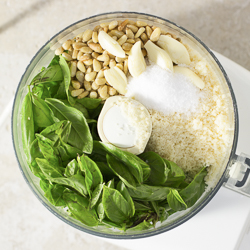From the Zinfandel chapter of “100 Perfect Pairings: Main Dishes to Enjoy with Wines You Love” by Jill Silverman Hough (Wiley, 2011). Photo by Lucy Schaeffer.
You won’t believe how mouthwateringly flavorful these chops are, thanks to a deceptively simple rub and an amazing sauce.
If you have the time, brine the chops, and then to let the rub sit on the meat for an hour or two. If not, just sprinkle on the rub and grill.
While you’re at it, toss some quartered bell peppers or halved zucchini on the grate—they’d be good alongside.
Serves 4
- 1 tablespoon smoked paprika (see note below)
- 1 tablespoon chili powder
- 1 1/2 teaspoons granulated garlic powder
- 1 1/2 teaspoons granulated onion powder
- 1 teaspoon chopped fresh thyme
- 2 3/4 to 4 teaspoons coarse kosher salt, divided, or more to taste
- 4 pork rib chops, about 1 inch thick, ideally brined (see below)
- 1/2 onion (halved through the root end)
- 4 plum tomatoes, halved lengthwise and seeded
- 1 tablespoon extra virgin olive oil
- 1 tablespoon tomato paste
- 1 1/2 teaspoons red wine vinegar, or more to taste
In a shallow bowl, combine the paprika, chili powder, garlic powder, onion powder, thyme, and 1 1/4 teaspoons of the salt (or 2 1/2 teaspoons if you didn’t brine). Arrange the pork on a platter or large plate in a single layer and sprinkle the rub on both sides. Cover and refrigerate for 1 to 2 hours.
Return the pork to room temperature.
Keeping the root end intact, cut the onion into 6 wedges. In a large bowl, toss the onion, tomatoes, olive oil, and remaining 1 1/2 teaspoons of salt. Set aside.
Prepare the grill to medium-high heat and lightly oil the grate. Grill the pork until cooked through, about 6 minutes per side. Grill the onion until softened and lightly charred, 4 to 5 minutes per side. Grill the tomatoes, skin side down, until softened and lightly charred, about 2 minutes. Transfer the pork to a platter or plates and let it rest, loosely covered with foil, for 5 minutes.
Meanwhile, in the bowl of a food processor, combine the onion, tomatoes, tomato paste, and vinegar and pulse to puree, scraping down the bowl as necessary. Taste, ideally with your wine, and add more salt and/or vinegar if you like.
Serve the pork chops in a pool of tomato sauce, drizzled with any accumulated juices.
NOTE Smoked paprika is available in the spice section of most major supermarkets and at specialty food stores. Besides using it in this recipe, you can use it in rubs and stirred into salsa, soups, stews, and sauces.
HOW TO BRINE Brining makes a huge difference with relatively lean cuts of meat that can have a tendency to dry out, helping to keep the meat both juicy and flavorful. If you have the time, I highly recommend it, particularly for pork. It’s also great for turkey, especially for a whole bird, when it’s so easy for the white meat to get dried out waiting for the dark meat to get adequately cooked.
To make a basic brine, combine 2 cups of cool water and 3 tablespoons of coarse kosher salt (use that same proportion to make a larger quantity of brine), stirring to dissolve the salt. Transfer the mixture to a resealable plastic bag, add your meat, and set it aside in the refrigerator. For 1-inch-thick chops or a pork tenderloin, brine for 4 to 6 hours. For a turkey breast, brine for 8 to 12 hours. And for a whole pork loin or whole turkey, brine for 12 to 24 hours (you might need to use a container larger than a resealable bag, then add a plate with something heavy on top to keep the meat submerged).
Remove the meat from the brine (discard the brine), pat it dry, and proceed with your recipe. It’s that easy—and it makes such a difference.









